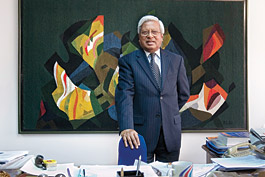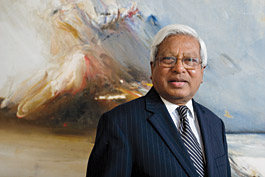
For students: We hope this guide will help sharpen your reading skills and deepen your understanding of this issue’s articles.
For teachers: We encourage reproduction and adaptation of these ideas, freely and without further permission from Saudi Aramco World, by teachers at any level, whether working in a classroom or through home study.
— THE EDITORS
Class Activities
This issue’s activities, all of which focus on
“Bangladesh’s Audacity of Hope,” fall into
three sections. The first is based on the notion
that “poverty must be tackled from a holistic
viewpoint.” (“Holistic” means trying to look
at something from as many different ways as
you can.) The second uses information about
BRAC to understand key ideas about economics.
The third section, Visual Analysis, analyzes
one photograph that accompanies the article,
and another one that doesn’t!
Theme: A Holistic Approach to Tackling
Poverty
In the article, Kenyan activist Wangari
Maathai is quoted saying that Fazle Hasan
Abed founded the Bangladesh Rural Advancement
Committee “on the belief that poverty
must be tackled from a holistic viewpoint.”
Through the activities in this section, you will
have a chance to explore what that means.
Problems—Actions—Outcomes
“Bangladesh’s Audacity of Hope” describes
numerous problems that face the poorest
people of Bangladesh. BRAC has tried to do
something about many of these problems,
and its actions have helped reduce the severity
of the problems. Read the article, paying
particular attention to what the problems are,
what actions BRAC has taken, and what has
resulted. Working with a small group, write
what you discover into the following chart,
which contains one completed example for
you. Add more lines if you have to. After you
fill in the chart, you will have a chance to
study its contents more closely.
| Problem |
Intervention |
Outcome |
| 25% infant mortality (children dying very young) |
Door-to-door education in oral rehydration |
7% infant mortality |
| |
|
|
| |
|
|
What Makes “Poverty”?
Poverty, of course, refers first to having little
money and few material possessions. But
there is more to it: There are many other
problems that poor people often have to face.
With your group, look at the problems you
have listed in the left-hand column of your
chart. Discuss the question: How does each
relate to poverty? Does poverty cause the
problem? Does the problem cause poverty?
Or both? How? Let’s look at the example
above: a high rate of infant mortality. How
does that relate to poverty? Poor people often
lack access to good health care, which may cause babies to be born prematurely or with
health problems. Poor people may also suffer
from poor nutrition and the kinds of diseases
that spread from poor sanitation (for example,
the diarrhea that BRAC has tried to reduce). So
a high infant mortality rate can be seen as a
reality that often accompanies poverty.
With your group, go through the other
problems on your chart. With each one, follow
a train of thought modeled after the example
in the previous paragraph. Write a sentence or
two that explains the relationships you have
identified between each problem and poverty.
When you’re done, you should have a good
sense of the many problems people experience
when they are poor, and how these
make it difficult to escape from poverty.
A Holistic Approach
Now return to the quote that describes BRAC’s
philosophy: that poverty must be “tackled
from a holistic viewpoint.” Turn your attention
to the second column of your chart. If the first
column identifies the problems of poverty, the
interventions in the second column identify
ways of addressing those problems. Look
closely at your second-column list. Each action
on the list is one part of a bigger strategy to
combat poverty. Based on these interventions,
what do you think a “holistic” approach would
be? Discuss the question with your group.
After your discussion, work on your own to
write a paragraph that uses examples from
BRAC to answer these questions: What is a
“holistic approach to tackling poverty”? Why
do BRAC leaders believe that such an approach
is necessary?
Theme: Economics
You may have studied economics in a textbook,
or looked up economic terms in a glossary.
But the ideas of economics make the
most sense when you see them in action, and
“Bangladesh’s Audacity of Hope” has some
great real-life examples. In this section of the
“Classroom Guide,” you’ll define a few of
these concepts, and you’ll see how they play
out in BRAC’s work. By the time you’re finished,
hopefully you will have a deeper understanding
of both economics and BRAC’s efforts.
Incentives
As a class, discuss the meaning of the term incentive. If you’re not sure what it means, go
to an online economics glossary and find out.
Then take two minutes and write down experiences
with incentives that you’ve had in your
own life, or examples of incentives that you’ve
seen in movies or maybe in the news. Then
have volunteers share some of their examples
with the class.
Working with a partner, return to “Bangladesh’s
Audacity of Hope” and find the passages
that deal with incentives. Reread and
highlight them. With your partner, discuss
how BRAC uses incentives in its programs.
Then, working on your own, write a paragraph
that defines incentives and then
explains how BRAC uses incentives to improve
the lives of people in Bangladesh. For good
measure, add a concluding sentence or two
explaining how providing incentives can be
part of “tackling” poverty.
Opportunity Costs
Opportunity cost is another important economic
concept. With your partner, find a definition
of opportunity cost and brainstorm
examples of opportunity costs in your own
experience. Here’s a hypothetical example to
get you started. Let’s say that you’ve saved
enough money to buy a pair of shoes or
a sweater, but not both. If you choose the
sweater, the opportunity cost is the shoes
you can’t get; if you choose the shoes, the
opportunity cost is the sweater. The concept
of opportunity cost works for time, too.
If you stay up an extra hour to study, the
opportunity cost is the hour of sleep that you
lose. If, on the other hand, you go to sleep
rather than study another hour, the opportunity
cost is whatever you might have learned
in that extra hour.
Once you’re clear on the concept of opportunity
cost and have thought about it in your
own experience, go back to the article with
your partner and find where opportunity costs
are addressed. What situation does the article
describe? What is the opportunity cost in that
situation? With your partner, discuss who in
Bangladesh might think the benefit gained is
worth the opportunity cost and who might
not think so. Why do you think each person
might hold the opinion he or she holds? If
you were to try to persuade one of these
people to change his or her opinion, how
would you do it?
Vertical Integration
Vertical integration is a business term that
describes what happens when a single business
controls different stages of producing
something and selling it to people. (For example,
when the parent company of this magazine’s
publisher sells crude oil to a buyer who
then refines it, that’s not vertical integration;
however, when Saudi Aramco refines its own
crude oil into gasoline and sells it at gas
stations that it owns in Saudi Arabia, that
is vertical integration.)
According to “Bangladesh’s Audacity
of Hope,” BRAC practices a form of vertical
integration. Find the part of the article that addresses vertical integration. Make a
graphic that shows how vertical integration
works at BRAC. To help you in your thinking,
you might want to make a graphic that also
shows vertical integration for other products
and businesses that feel familiar to you.
Then see how the different kinds of projects
at BRAC are like them, and different.
Microfinance
Microfinance is a term you might not find in
your average economics textbook. But it’s a
term that you should know to be an informed
citizen of the 21st century. Microfinance refers
to making very small loans to very poor people,
usually in developing countries. Microfinance
institutions lend money to people that
regular banks would likely ignore. The microfinancer’s
aim is to help those they lend money
to work their way out of poverty. Do some
Internet research to answer these questions:
1) What makes microfinance different from
conventional banking? 2) What makes it so
important in developing countries like Bangladesh?
and 3) What are some of the effects
of microfinance?
Visual Analysis
  |
| SHEHAB UDDIN (2) |
The portrait at left, above, of BRAC founder and chairperson Fazle Hasan Abed, appears in the article’s Portrait Gallery. It was taken by Shehab Uddin, a student at Pathshala, the
South Asian Institute of Photography in
Dhaka, Bangladesh. Uddin took a magazine
photography workshop with Saudi Aramco
World Managing Editor Dick Doughty and
photographer Amin Aminuzzaman.
With your classmates, take a long look
at the picture. Here are a few questions to
get you going: What is behind the subject?
What is in front of him? What is the place
he is in? What is he doing? What can you
tell about him from the photo? How can
you tell? Share your observations with the
rest of the class.
Now look at Uddin’s other photograph
of Abed, right. How is it different?
What can you tell about Abed from this
photograph? How? Which photo do
you prefer? Why?
Now here is what Doughty had to say
about what he and Uddin discussed in the
workshop: “Shehab preferred [the righthand photo of Abed] because to
him, the motion and color in the abstract
painting behind Abed symbolized BRAC’s
rapid, positive changes in the country, as
well as modernity. Also, he said that the
painter is one of the most famous in Bangladesh.
I argued that is meaningful if you
know Bangladeshi art, but because most of
our readers don’t, they aren’t likely to understand
that. On the other hand, the background
image in the portrait-with-desk has
both a modern and a bit of a traditional look
to it, and that fits better with what our readers
will learn in this story. But most of all I
liked the cluttered desk. It tells us he is busy
and ‘an ordinary guy,’ because lots of us
have cluttered work areas no matter what
we do. This helps our readers relate to him,
even though he lives in a place that’s far
away. Thus we concluded in our workshop
that Shehab’s photo would work well in a
Bangladeshi magazine—it’s a good shot,
and it shows his face better—but my choice
worked better for Saudi Aramco World.”
Based on Doughty’s explanation, list
three considerations that went into publishing
the photograph of Abed that appears
in the Portrait Gallery. Now step back and think about
magazine photography more generally.
What does a photographer consider when
he or she is taking a photograph of someone
for a magazine? What does the choice
of background do to what we think about
a person in a photograph?
Now try it yourself. Pair up with another
student and take four portraits of that person.
Take each portrait in a different setting,
remembering that the setting tells a viewer
a lot about the person in a photograph.
When the photos are done, divide the class
into groups of four or five. Share your photos
with your group. Ask group members
what each photo “tells” them about the person
in it. Then explain what you intended
to convey with the settings your chose.
Did you succeed
| Julie Weiss is an education
consultant based in
Eliot, Maine. She holds a
Ph.D. in American studies.
Her company, Unlimited
Horizons, develops social
studies, media literacy and
English as a Second Language
curricula, and produces
textbook materials. |